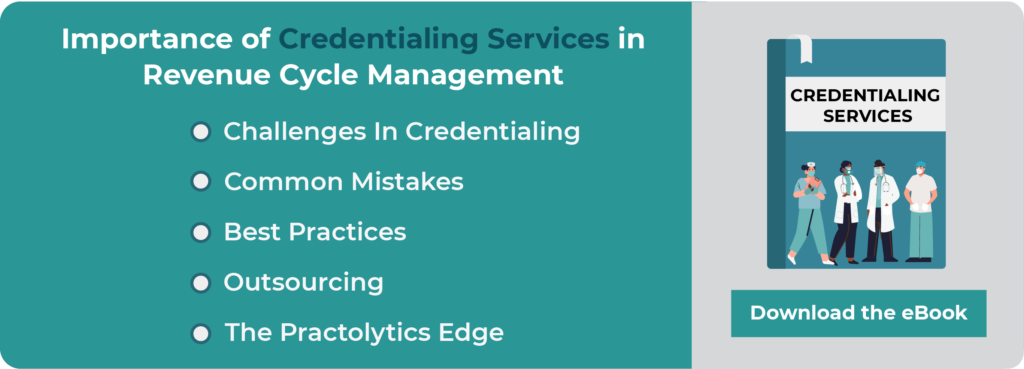Strategies to Reduce Credentialing Backlogs in 2024
This guide explores effective strategies to reduce credentialing backlogs in 2024, including automation, streamlined verification, outsourcing, and regulatory compliance. Learn how to optimize workflows, improve turnaround times, and ensure seamless provider onboarding in healthcare and other industries.
In the ever-evolving realm of healthcare, where precision and proficiency are paramount, the process of credentialing stands as a vital gateway to ensuring the competence and qualifications of healthcare professionals. The meticulous scrutiny involved in verifying licenses, qualifications, and other pertinent credentials is an integral task in maintaining the integrity and quality of healthcare services. However, despite its fundamental importance, the persistent challenge of credentialing backlogs continues to cast a shadow over the industry, impeding the swift and effective deployment of much-needed skilled practitioners.
As we embark on the journey into 2024, it becomes increasingly evident that addressing the longstanding issue of credentialing backlogs is not just a necessity but a collective responsibility. The intricacies of this process, involving multiple stakeholders ranging from medical boards to hospitals and insurance providers, have created a complex web that often leads to delays and inefficiencies. The surge in demand for healthcare services, coupled with a continual influx of professionals entering the field, has added a layer of complexity to the already intricate credentialing process.
Outdated manual procedures, lack of standardization across healthcare organizations, and the voluminous nature of documentation have collectively contributed to a bottleneck that affects not only the professionals seeking accreditation but also the healthcare institutions striving to swiftly integrate them into the workforce. In this landscape, the need for innovative solutions has never been more pressing. As we delve into the strategies to reduce credentialing backlogs in 2024, it’s essential to explore not only the challenges but also the transformative potential of advanced technologies, collaborative efforts, and a proactive approach to empower healthcare professionals themselves.
The convergence of these elements holds the promise of not only streamlining the credentialing process but also ushering in an era where the deployment of skilled practitioners aligns seamlessly with the dynamic demands of the healthcare landscape.
Table of Contents
Understanding Credentialing Backlogs in 2024
Credentialing involves the verification of a healthcare professional’s qualifications, licenses, and other relevant credentials. The process is intricate and involves multiple stakeholders, including medical boards, hospitals, and insurance providers. Despite its significance, the system is often plagued by delays and inefficiencies, leading to a backlog of pending applications.
Several factors contribute to credentialing backlogs, such as outdated manual processes, the complexity of documentation, and a lack of standardization across healthcare organizations. Additionally, the surge in demand for healthcare services, coupled with an ever-expanding pool of healthcare professionals, has exacerbated the problem.
Embracing Technological Advancements
In 2024, one of the most effective ways to tackle credentialing backlogs is through the integration of advanced technologies. Automation and artificial intelligence can significantly expedite the verification process, reducing the burden on administrative staff and minimizing errors.
Implementing a centralized, cloud-based credentialing system allows for real-time collaboration between different entities involved in the process. This not only enhances transparency but also ensures that all stakeholders have access to the most up-to-date information, eliminating the need for redundant paperwork and multiple verification steps.
Standardization for Efficiency
Standardization is a key element in addressing credentialing backlogs. Establishing uniform criteria and documentation requirements across healthcare organizations can simplify the verification process. This not only streamlines the initial credentialing but also facilitates the ongoing monitoring and updating of professional qualifications.
Collaboration between healthcare institutions, accrediting bodies, and regulatory agencies is essential to develop standardized guidelines. This collaborative effort can result in a shared database of verified credentials, making it easier for organizations to access accurate information quickly.
Utilizing Blockchain Technology
Blockchain technology offers a secure and transparent solution to credentialing challenges. By storing credentials in a decentralized and tamper-resistant database, blockchain ensures the integrity and authenticity of the information. This can prevent fraud and expedite the verification process, ultimately reducing credentialing backlogs.
Implementing blockchain in credentialing requires a collaborative effort within the healthcare industry to establish a standardized blockchain network. This network can serve as a shared ledger for verified credentials, accessible to all authorized parties, thereby eliminating redundant verification steps.
Empowering Healthcare Professionals
Another aspect often overlooked in addressing credentialing backlogs is empowering healthcare professionals themselves. Providing practitioners with user-friendly, digital platforms to manage and update their credentials can streamline the initial verification process.
Developing a secure and standardized online portal for professionals to submit and update their credentials allows for a more proactive approach. This not only expedites the initial verification but also facilitates ongoing updates, ensuring that all information remains current.
Strengthening Regulatory Support
Regulatory bodies play a pivotal role in shaping the credentialing landscape. Collaborative efforts between these bodies and healthcare organizations can lead to the development of streamlined processes and effective solutions. Additionally, regulatory bodies can leverage technology to enhance their oversight and monitoring functions, ensuring compliance with established standards.
Providing clear guidelines and support for healthcare organizations to implement efficient credentialing processes is essential. Regular audits and evaluations can help identify bottlenecks and areas for improvement, fostering a culture of continuous enhancement.
In short, as we have entered the new year, it’s crucial for the healthcare industry to prioritize the optimization of credentialing processes. Embracing technological advancements, standardizing procedures, and fostering collaboration among stakeholders are key to reducing credentialing backlogs in 2024. By implementing these strategies, the industry can ensure that qualified healthcare professionals are swiftly integrated into the workforce, ultimately benefiting both providers and patients alike.
As a forward-thinking company committed to revolutionizing healthcare processes, Practolytics stands at the forefront of this transformative journey. Our cutting-edge solutions leverage advanced technologies to provide a comprehensive and streamlined credentialing platform. By prioritizing efficiency and transparency, Practolytics aims to be an instrumental ally in the collective effort to reduce credentialing backlogs and pave the way for a more agile and responsive healthcare ecosystem. Together, we can navigate the intricacies of the credentialing maze, ensuring that the deployment of skilled healthcare professionals aligns seamlessly with the dynamic demands of the industry.
ALSO READ – Charting the Future: Navigating 2024’s Healthcare Credentialing with Practolytics
Talk to Medical Billing Expert Today — Get a Free Demo Now!






